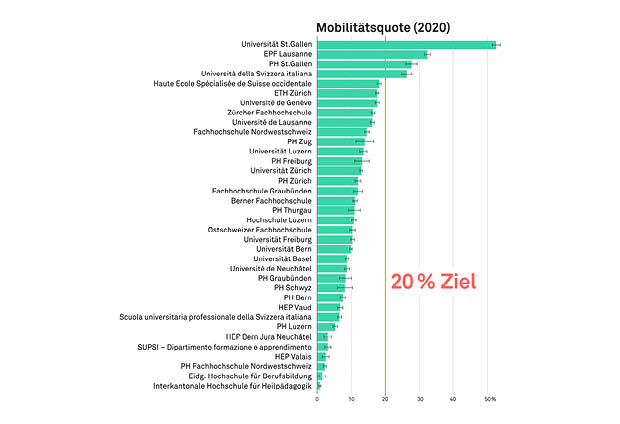Major differences in mobility opportunities for Swiss students
With regard to student mobility, the vast majority of Swiss higher education institutions are still far from the vision and objectives of the national strategy of the Confederation and the cantons and of the European Higher Education Area (20% of graduates should have studied or acquired practical experience abroad). The average mobility rate of Swiss higher education institutions is currently at 15.7%. Many show a significant lower rate.
New internationalisation index compares mobility rates
In 2021, the national agency Movetia commissioned a study to analyse the international mobility rates of Swiss higher education institutions as well as the factors promoting mobility. On this basis, and for the first time in Switzerland, an internationalisation index was established, which compares the individual mobility rates at national level. The mobility data were provided by the Federal Statistical Office (FSO) and give information on the pre-pandemic mobility behaviour of 2020 graduates (Bachelor’s and Master’s degrees). Thus, the index is not affected by negative effects related to the corona pandemic.
Significant differences between higher education institutions and surprising results
The mobility rates at Swiss higher education institutions range widely from 1% to 50%. Only four out of the 36 universities surveyed meet the target of 20%. The average mobility rate of 15.7% of mobile students at the end of their studies (2020) is only achieved thanks to the exceptional performance of the institutions placed among the top three.
The position of higher education institutions within the ranking is not related to the type of institution they belong to (university, university of applied sciences, or university of teacher education), nor does it seem to depend on their size, their years of existence or the linguistic region in which they are located. The University of St.Gallen, EPF Lausanne, HEP St.Gallen, Università della Svizzera italiana and the University of Applied Sciences Western Switzerland (HES-SO) make up the top five (in this order). This shows that despite very different contexts, it is possible for all types of higher education institutions to achieve high mobility rates.
Framework and mindset are crucial
If the framework and the institutional mindset are right, students tend to be mobile. The study shows a significant correlation between the mobility rate and the degree of internationalisation of higher education institutions. The ones that invest intensively in one or more internationalisation factors show a higher mobility rate. Three factors stand out as important catalysts for outgoing mobility: Study programmes with an international orientation, an international study environment, and attractive conditions for incoming students.
Relevance for the economy and innovation
Both a high mobility rate and the internationalisation of the higher education area are of great importance for Switzerland as a country of innovation, as well as for the local economy. An exchange experience during their studies means significant added value for the students: they develop important intercultural, professional and personal skills, and their employability and career opportunities increase. Mobility therefore is a fundamental part of Swiss graduates’ educational pathway and it also contributes to bring highly qualified incoming students and trainees into sectors with a shortage of skilled workforce. Furthermore, mobility is an important driving force for scientific exchange, networking, and for cooperation between research and educational institutions.
Olivier Tschopp, Movetia’s Director, is convinced: “The significant differences between mobility rates should show Swiss education stakeholders that initiatives are needed in order to ensure that all students have similar mobility opportunities. This publication points out that the decision to go on a mobility or not does not lie exclusively with the students. Swiss higher education institutions and the national educational framework have an important role to play in achieving the mobility objectives that have been set, in order to allow Switzerland to remain an attractive country for education and innovation.”
The new internationalisation index and its mobility rates illustrate how important it is to pursue a systematic approach when promoting mobility: an approach ranging from university governance and strategic objectives, to the design of study programmes. The index clearly shows which Swiss higher education institutions are in need for action and provides the institutions and their governance with important insights, impulses and best practices on how to implement internationalisation and mobility successfully.
![[Translate to english:] [Translate to english:]](/fileadmin/_processed_/6/c/csm_Mobilit%C3%A4tsindex-DE_c39f8f10a0.jpg)
![[Translate to english:] [Translate to english:]](/fileadmin/_processed_/d/b/csm_Mobilit%C3%A4tsindex-DE_2_38afccd0a3.jpg)
